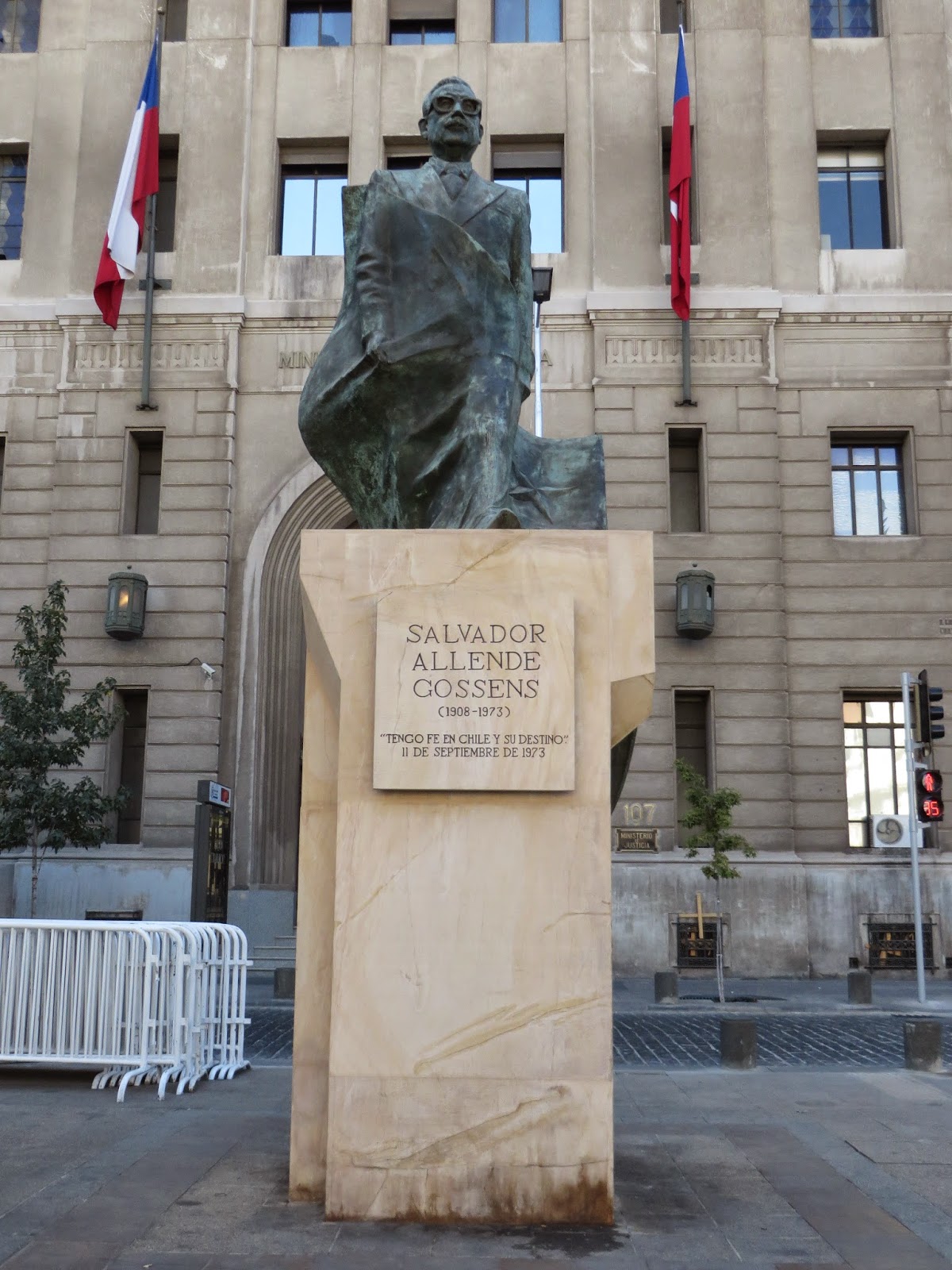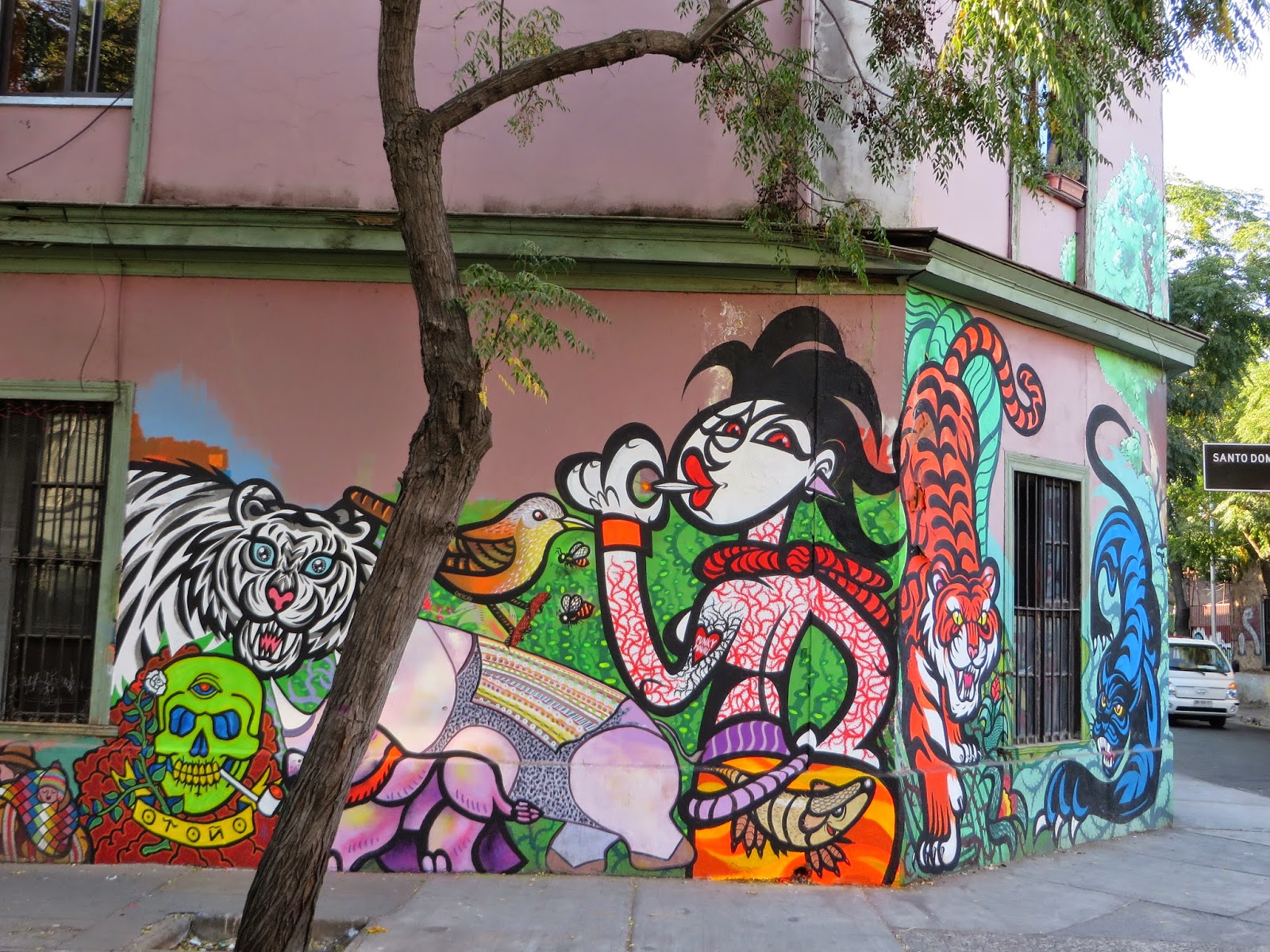Most Habitat for Humanity Global Village trips include a few days during which we do some exploring locally or near the city or town of the build project. In this case, we had three major R&R activities - human rights walking tour in Santiago, a day trip to Vina del Mar/Valparaiso and a tour of the Conch y Toro winery near Santiago.
Human Rights Walking Tour
On our first full day in Santiago, we went on a guided human rights walking tour. The tour provided a good introduction to the key social and political issues that Chile has faced over the past 40 years or so. Our tour guide led us to many important sites related to the events of the period from 1973-1990 when the country was under the military dictatorship of Augusto Pinochet. Horrific human rights offenses occurred at many of these sites or they are sites of importance to the struggle for memory and reconciliation. For example, the tour took us to the presidential palace where Salvador Allende was located when the military takeover was solidified by bombing the palace. While the country has made a significant political and social shift to democracy since 1990, we were told that many Chileans continue to struggle with matters of healing and reconciliation associated to the military dictatorship.
We also visited the cemetery that is home to a large wall listing the names of the missing, disappeared and dead from the 1973-1990 period. It is extremely unsettling to see the names of so many people. While the date of death is indicated for many people, there are hundreds for whom the date listed is when they were last seen by their family or friends. There is one area in particular where the very basic grave markers are placed in long rows somewhat similar to the crosses of Flanders Fields.
Human Rights Walking Tour
On our first full day in Santiago, we went on a guided human rights walking tour. The tour provided a good introduction to the key social and political issues that Chile has faced over the past 40 years or so. Our tour guide led us to many important sites related to the events of the period from 1973-1990 when the country was under the military dictatorship of Augusto Pinochet. Horrific human rights offenses occurred at many of these sites or they are sites of importance to the struggle for memory and reconciliation. For example, the tour took us to the presidential palace where Salvador Allende was located when the military takeover was solidified by bombing the palace. While the country has made a significant political and social shift to democracy since 1990, we were told that many Chileans continue to struggle with matters of healing and reconciliation associated to the military dictatorship.
One of the memorials at the cemetery is for Victor Jara, a singer-song writer and political activist. Under the Allende government, Jara was a leader in the revolution of popular music in Chile. Shortly after the military coup in September 1973, Jara was arrested, tortured and shot dead. His brutal murder is a sharp contrast to the themes of his music - love, justice and peace. He continues to be a symbol of the struggle for human rights globally.
Even though the content is very challenging and not for everyone, I highly recommend the tour along with spending time at the Museum of Memory and Human Rights.
Vina del Mar/Valparaiso
One of our day outings took us to the adjacent coastal cities of Vina del Mar and Valparaiso, with the highlight clearly being the colourful, funky Valparaiso. The first stops were in Vina del Mar and these included visits to memorials to the Noel Prize literature recipients Pablo Neruda and Gabriela Mistral. Next stop was the beach, which was especially appreciated by those on the team who do not live near the ocean. After having lunch, the next destination was Valparaiso, where we were dropped off on a hill overlooking and then we walked through a myriad of streets to make our way down to the centre of the city just a short distance from the ocean.
Valparaiso is a major city, educational centre and an important port. It also is the headquarters for the Chilean National Congress and shipping plays a key economic role. In 2003, the city was declared a UNESCO World Heritage site and via a national law it has had been designated as Chile's Cultural Capital.
Over the past 15-20 years, Valparaiso has experienced an notable renaissance attracting many artists and tourists. It's colourful houses and buildings, murals, cobbled streets, festivals, street artists and musicians are reflections of its appealing character. On another trip to Chile will require more time in Valparaiso.
Vina del Mar/Valparaiso
One of our day outings took us to the adjacent coastal cities of Vina del Mar and Valparaiso, with the highlight clearly being the colourful, funky Valparaiso. The first stops were in Vina del Mar and these included visits to memorials to the Noel Prize literature recipients Pablo Neruda and Gabriela Mistral. Next stop was the beach, which was especially appreciated by those on the team who do not live near the ocean. After having lunch, the next destination was Valparaiso, where we were dropped off on a hill overlooking and then we walked through a myriad of streets to make our way down to the centre of the city just a short distance from the ocean.
Valparaiso is a major city, educational centre and an important port. It also is the headquarters for the Chilean National Congress and shipping plays a key economic role. In 2003, the city was declared a UNESCO World Heritage site and via a national law it has had been designated as Chile's Cultural Capital.
Over the past 15-20 years, Valparaiso has experienced an notable renaissance attracting many artists and tourists. It's colourful houses and buildings, murals, cobbled streets, festivals, street artists and musicians are reflections of its appealing character. On another trip to Chile will require more time in Valparaiso.
An Outing to Concha y Toro Winery
One of the top-of-mind thoughts about Chile - an accurate thought - is that it produces good wines. Consequently, it makes a lot of sense to visit a winery when visiting the country. On our second day of R&R, we took a half-day guided tour of the Concha y Toro winery near Santiago.
In a country that is a major global wine producer, Concha y Toro is Chile's largest volume producer. It has been in operation for about 130 years and has vineyards/operations in six important growing valleys. Our tour was at the original estate of the family that started the company at Pirque in the Maipo Valley. The guide showed us through key areas of the estate, gave us a quick primer grape vines showcasing the wines produced in that location, and we got to walk in and through some of the wine storage cellars, especially the famous cellar where the Casillero del Diablo line of wines gained its legend. The tour was enhanced with a few samples and, of course, concluded at the gift shop. Here are few photos to tell the story.
- See more at: http://www.conchaytoro.com/web/tour-en/#sthash.vlGmWchP.dpuf
In a country that is a major global wine producer, Concha y Toro is Chile's largest volume producer. It has been in operation for about 130 years and has vineyards/operations in six important growing valleys. Our tour was at the original estate of the family that started the company at Pirque in the Maipo Valley. The guide showed us through key areas of the estate, gave us a quick primer grape vines showcasing the wines produced in that location, and we got to walk in and through some of the wine storage cellars, especially the famous cellar where the Casillero del Diablo line of wines gained its legend. The tour was enhanced with a few samples and, of course, concluded at the gift shop. Here are few photos to tell the story.
The Wine Tourist Center of Concha y Toro is the
principal winemaking attraction of Santiago. It’s located in Pirque in
the Maipo Valley, a privileged area for the production of world-quality
wines. The Centre is located one hour from the city.
The old cellars and vineyards of Concha y Toro are part of Chile’s winemaking tradition. Founded in 1883, it is now one of the most important wineries in the world.
The old cellars and vineyards of Concha y Toro are part of Chile’s winemaking tradition. Founded in 1883, it is now one of the most important wineries in the world.
The Wine Tourist Center of Concha y Toro
is the principal winemaking attraction of Santiago. It’s located in
Pirque in the Maipo Valley, a privileged area for the production of
world-quality wines. The Centre is located one hour from the city.
The old cellars and vineyards of Concha y Toro are part of Chile’s winemaking tradition. Founded in 1883, it is now one of the most important wineries in the world.
- See more at: http://www.conchaytoro.com/web/tour-en/#sthash.vlGmWchP.dpuf
The old cellars and vineyards of Concha y Toro are part of Chile’s winemaking tradition. Founded in 1883, it is now one of the most important wineries in the world.
- See more at: http://www.conchaytoro.com/web/tour-en/#sthash.vlGmWchP.dpuf







































































